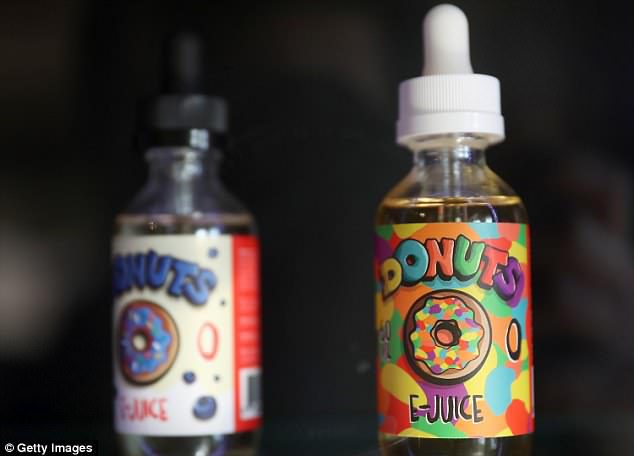The chemicals used to flavor e-cigarettes may be toxic, new research suggests.
Substances that give the tobacco substitute a citrus or floral scent significantly increase the production of free radicals, a US study found.
Free radicals are molecules that damage healthy cells and have been linked to inflammation, heart disease, and cancer.
Although 43 percent of e-cigarettes on the market contain chemicals that boost free-radical production, for unclear reasons, vanilla flavorings actually reduce their levels by 42 percent, the research adds.
Yet, a study released just last month suggested vanilla-scented e-cigarettes are just as toxic as other flavors.
The previous research also implied many e-liquids contain dangerous chemicals, including vegetable glycerin and propylene glycol, to get their flavours, both of which damage human cells.
In the US, between 15 and 25 percent of students in the 11th and 12th grade of high school have tried vaping, while around 15 percent of adults use e-cigarettes.

The chemicals used to flavor e-cigarettes may be toxic, new research suggests (stock)
E-cigarette flavorings have not been assessed for safety when heated
Although the flavorings used in e-cigarettes are approved for human consumption, their safety has never been evaluated when heated.
Study author Professor John Richie explained: ‘E-cigarettes have a coil for heating the liquid that gets quite hot and may aid the production of free radicals.
‘It’s important to look at the effect of flavors on these free radical levels because e-cigarettes come in hundreds of flavors, many of which are marketed toward kids, like bubblegum.’
The scientists carried out the research by comparing 49 e-cigarette flavors against a flavorless liquid.
These flavors were then broken down to determine their individual chemical contents.
Chemicals that give off citrus or floral flavors include linalool, dipentene and citral.
Ethyl vanillin creates vanilla notes.
Study author Zachary Bitzer added: ‘Two different manufacturers may sell an “orange” flavored e-liquid, but they could each contain vastly different flavorants to get that orange flavor.
‘Just like Coke and Pepsi are both colas but have different ingredients, different flavors of e-cigarettes may contain different flavorants, resulting in different levels of free radicals.’
The researchers hope their findings, published in the journal Free Radical Biology and Medicine, will inform vapers about which e-cigarettes to use and help the FDA establish guidelines on how to ensure the devices’ safety.

Many e-liquids contain various dangerous chemicals to get their flavour, including vegetable glycerin and propylene glycol, which are both damaging to cells, UNC researchers found
E-cigarette flavors are ‘more toxic than nicotine’
Dr Robert Tarran, who was behind research by University of North Carolina at Chapel Hill investigating the toxicity of e-cigarette flavours, said: ‘We found that e-liquid ingredients are extremely diverse, and some of them are more toxic than nicotine alone and more toxic than just the standard base ingredients in e-cigarettes – propylene glycol and vegetable glycerin.
‘The FDA, which helped fund our study, is just beginning to regulate e-liquid ingredients and we hope our data will inform their efforts.’
Last month, seven leading health agencies sued the FDA for delaying a review of e-cigarettes, warning there is plenty of evidence the as-yet unregulated devices could be wrecking havoc on users’ health.
The UNC scientists sampled 148 e-liquids – out of 7,700 on the market – and performed a rapid evaluation of e-liquid toxicity using large plastic plates with tiny indentations, exposing fast-growing human cells to various e-liquids.
The key thing they were looking for was a slowed growth rate, which indicates higher toxicity.
As expected, they found e-liquids’ main ingredients propylene glycol and vegetable glycerin, which are not toxic when swallowed, are incredibly dangerous when inhaled.
In general, the findings showed that the more ingredients an e-cigarette contains, the more toxic the liquid is.
The most toxic flavors, they found, came from the compounds vanillin and cinnamaldehyde, which feature in many flavored liquids.
If you know someone who might like this, please click “Share!”




